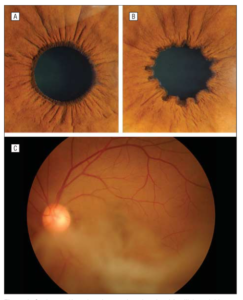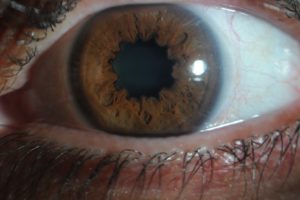OFTHALMOLOGICAL REPERCUSSIONS FROM THE ONSET OF FAMILIAL AMYLOID POLYNEUROPATHY
Amyloid neuropathy is a genetic disorder caused by the mutation of the transport protein transthyretin, resulting in the formation of the protein fragment amyloid, that is deposited on various organs. The amyloid is produced in the liver and transferred with blood circulation to the rest of the organs. There are various mutations of the particular gene, but the Val30Met is the one that is mostly found in Cyprus. In the past few years, amyloidosis patients can undergo surgery that stops the liver from producing the amyloid.
Τhere is a complication however. The amyloid is also produced in the eye. The fact that amyloid production in the eye is independent of the liver, means that the eye is affected even in patients who have undergone a liver transplant. Clinical studies have shown that the repercussions of amyloid being deposited in the eye become progressively worse if more than seven years have elapsed from the liver transplant. Meanwhile, as the survival rate of amyloidosis patients rises, there are more and more who suffer from ophthalmological repercussions.
Τhe amyloid is produced in the eye by the pigment epithelium, one of the retina’s cell layers, just outside the neuro-sensory retina which nourishes retinal visual cells. The amyloid is deposited in almost all parts of the eye, but characteristically so in the iris, causing deformation of the pupil, in the eye’s lens where it creates α cataract, in the drainage angle of the eye causing a glaucoma and in the vitreous, the gel filling the space between the lens and the retina, where amyloid accumulation can cause severe blurring of vision. In addition amyloid accumulation in the conjunctiva can cause severe dryness.
Amyloid accumulation in the vitreous causes blurring of vision that comes and goes at the initial stages, in the form of floaters, but gradually worsens, leading to severe vision impairment in its final stages to the filtration of the vitreous by the amyloid. The problem can be remedied through a vitrectomy, a surgical procedure through which the ‘polluted’ vitreous is removed.
Αmyloid accumulation in the pupil causes a distinct and visible deformity which usually co-exist with distortions in the drainage angle of the eye leading to glaucoma. This is a condition that brings about increased pressure on the eyes or damages the optic nerve and peripheral vision. If not treated in its early stages it can lead to blindness. Unfortunately glaucoma patients have no initial symptoms from the conditions, it is therefore quite possible they’ll eventually go blind without realizing. Glaucoma associated with amyloid accumulation is particularly aggressive in its progression and all patients with amyloid accumulation in the iris must be under frequent ophthalmological observation in order to stop this complication in its tracks. If treated early with eye droms, laser or even surgery, then blindness is prevented.
Ιn conclusion, familial amyloid polyneuropathy patients, even if they’ve undergone a liver transplant, are at risk from the opthalmological repercussions of the illness. Therefore they must take eye tests regurarly (every 6 to 12 months according to the conditions) conducted by an ophthalmologist in order to prevent any complications.

Amyloid accumulation in the vitreous

Distortion of the pupil due to amyloid accumulation at its edges
